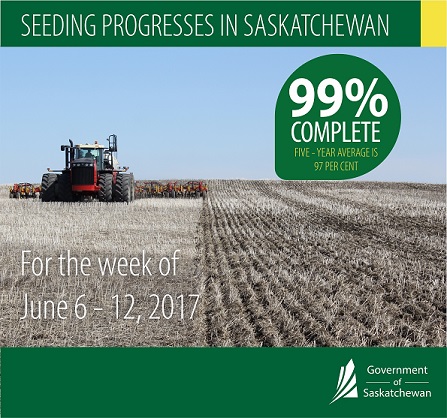Released on June 15, 2017
Seeding has essentially wrapped up in the province, according to Saskatchewan Agriculture’s Weekly Crop Report. Producers have 99 per cent of the crop in the ground, ahead of the five-year (2012-2016) seeding average of 97 per cent for this time of year. The northwest region is the furthest behind with 97 per cent seeded. Across the province, there are still a few fields of oats and barley, as well as some greenfeed and silage, left to be seeded.
The much-needed rainfall received this week will help replenish topsoil moisture and allow crops to advance. While much of the north has surplus topsoil moisture at this time, many areas in the south were relieved to see rain as crops, hay land and pastures were in need of significant moisture.
Prior to the recent rainfall, topsoil moisture conditions were deteriorating in southern and central areas of the province. Provincially, cropland topsoil moisture is currently rated as seven per cent surplus, 52 per cent adequate, 35 per cent short and six per cent very short. Hay land and pasture topsoil moisture is rated as four per cent surplus, 43 per cent adequate, 41 per cent short and 12 per cent very short.

Overall crop development has improved with the warm and wet weather. Sixty per cent of fall cereals, 62 per cent of spring cereals, 53 of oilseeds and 70 per cent of pulse crops are at their normal stages of development for this time of year. The majority of crops are in fair-to-excellent condition.
Persistent wind has damaged crops and delayed in-crop weed control operations in many areas. Cutworms, flea beetles, localized flooding, hail and lack of moisture have also caused damage this past week.
Producers are busy completing seeding, controlling weeds and getting ready for haying.
SaskPower reports that there have been 149 reports of power line contact this year, with 19 incidents reported in June.
A complete version of the Crop Report is available at http://www.publications.gov.sk.ca/redirect.cfm?p=85908&i=99541.
Follow the 2017 Crop Report on Twitter at @SKAgriculture.
-30-
For more information, contact:
Shannon Friesen
Agriculture
Moose Jaw
Phone: 306-694-3592
Email: shannon.friesen@gov.sk.ca

